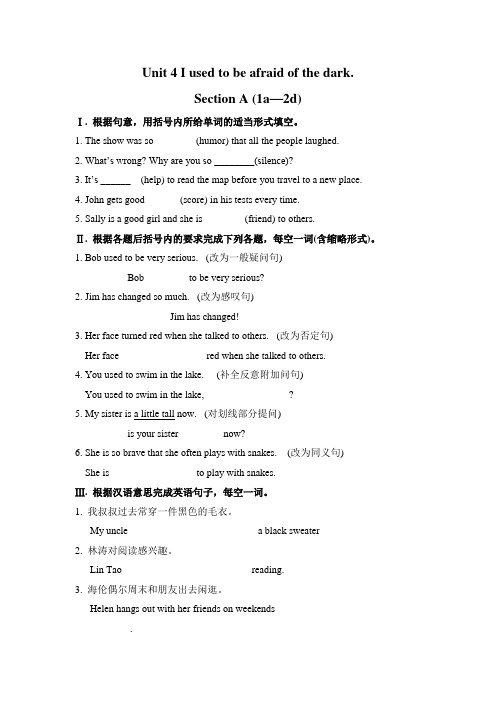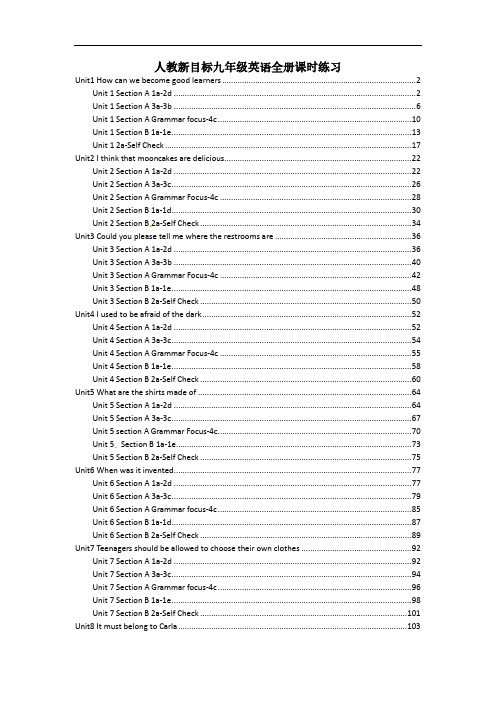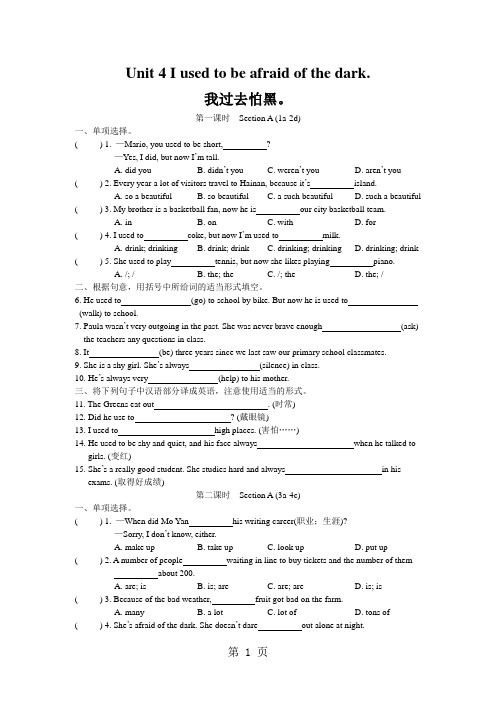新目标九年级英语Unit 4 Section A(1)
- 格式:ppt
- 大小:2.92 MB
- 文档页数:43

Unit 4 I used to be afraid of the dark.Section A (1a—2d)Ⅰ. 根据句意,用括号内所给单词的适当形式填空。
1. The show was so ________(humor) that all the people laughed.2. What’s wrong? Why are you so ________(silence)?3. It’s ________(help) to read the map before you travel to a new place.4. John gets good ______ (score) in his tests every time.5. Sally is a good girl and she is ________(friend) to others.Ⅱ. 根据各题后括号内的要求完成下列各题,每空一词(含缩略形式)。
1. Bob used to be very serious. (改为一般疑问句)________ Bob ________ to be very serious?2. Jim has changed so much. (改为感叹句)________ ________ Jim has changed!3. Her face turned red when she talked to others. (改为否定句)Her face ________ ________ red when she talked to others.4. You used to swim in the lake. (补全反意附加问句)You used to swim in the lake, ________ ________?5. My sister is a little tall now. (对划线部分提问)________ is your sister ________ now?6. She is so brave that she often plays with snakes. (改为同义句)She is ________ ________ to play with snakes.Ⅲ. 根据汉语意思完成英语句子,每空一词。

UNIT 4I used to be afraid of the dark.Section A(1a-4c)重点单词1. ________ adj. 有幽默感的;滑稽有趣的2. ________adj. 不说话的;沉默的3. ________ adj. 有用的;有帮助的4. ________ n. & v. 得分;进球5. ____________ n. 背景6. ________ v. 采访;面试n. 面试;访谈7. ________ adj. 亚洲(人)的n. 亚洲人8. ________ v. 对付;对待9. ________ v. 敢于;胆敢10. ________ n. 吨;(pl. )大量;许多11. ________ adj. 私人的;私密的12. ________ n. 警卫;看守v. 守卫;保卫13. ________ v. 需要;要求14. ________ adj. 欧洲(人)的n. 欧洲人15. ________ adj. 非洲(人)的n. 非洲人16. ________ adj. 英国(人) 的17. ________ n. 讲话;发言18. ________ n. 民众adj. 公开的;公众的单词变形1. humorous—________ (名词)2. silent—________ (名词)3. deal—________(过去式)—________ (过去分词)4. require—____________ (名词)重点短语1. __________________ 时常;有时2. ____________ 应对;处理3. ____________ 公开地4. ____________ 开始从事5. ____________ 放弃6. ____________ 闲逛重点句型1. —Mario,you ____________ short,didn't you?马里奥,你过去个子很矮,不是吗?—Yes,I did. 是的,我很矮。

人教新目标九年级英语全册课时练习Unit1 How can we become good learners (2)Unit 1 Section A 1a-2d (2)Unit 1 Section A 3a-3b (6)Unit 1 Section A Grammar focus-4c (10)Unit 1 Section B 1a-1e (13)Unit 1 2a-Self Check (17)Unit2 I think that mooncakes are delicious (22)Unit 2 Section A 1a-2d (22)Unit 2 Section A 3a-3c (26)Unit 2 Section A Grammar Focus-4c (28)Unit 2 Section B 1a-1d (30)Unit 2 Section B2a-Self Check (34)Unit3 Could you please tell me where the restrooms are (36)Unit 3 Section A 1a-2d (36)Unit 3 Section A 3a-3b (40)Unit 3 Section A Grammar Focus-4c (42)Unit 3 Section B 1a-1e (48)Unit 3 Section B 2a-Self Check (50)Unit4 I used to be afraid of the dark (52)Unit 4 Section A 1a-2d (52)Unit 4 Section A 3a-3c (54)Unit 4 Section A Grammar Focus-4c (55)Unit 4 Section B 1a-1e (58)Unit 4 Section B 2a-Self Check (60)Unit5 What are the shirts made of (64)Unit 5 Section A 1a-2d (64)Unit 5 Section A 3a-3c (67)Unit 5 section A Grammar Focus-4c (70)Unit 5Section B 1a-1e (73)Unit 5 Section B 2a-Self Check (75)Unit6 When was it invented (77)Unit 6 Section A 1a-2d (77)Unit 6 Section A 3a-3c (79)Unit 6 Section A Grammar focus-4c (85)Unit 6 Section B 1a-1d (87)Unit 6 Section B 2a-Self Check (89)Unit7 Teenagers should be allowed to choose their own clothes (92)Unit 7 Section A 1a-2d (92)Unit 7 Section A 3a-3c (94)Unit 7 Section A Grammar focus-4c (96)Unit 7 Section B 1a-1e (98)Unit 7 Section B 2a-Self Check (101)Unit8 It must belong to Carla (103)Unit 8 Section A 1a-2d (103)Unit 8 Section A 3a-3c (107)Unit 8 Section A Grammar Focus-4c (110)Unit 8 Section B 1a-1d (112)Unit 8 Section B 2a-Self Check (113)Unit9 I like music that I can dance to (117)Unit 9 Section A 1a-2d (117)Unit 9 Section A 3a-3c (118)Unit 9 Section A Grammar Focus-4c (121)Unit 9 Section B 1a-1d (122)Unit 9 Section B 2a-Self Check (124)Unit10 You’re supposed to shake hands (126)Unit 10 Section A 1a-2d (126)Unit 10 Section A 3a-3c (128)Unit 10 Section A Grammar focus-4c (131)Unit 10 Section B 1a-1d (133)Unit 10 Section B 2a-Self Check (135)Unit1 How can we become good learnersUnit 1 Section A 1a-2d(总分:100分时间:60分钟)I. 单项选择(本题包括10小题,每题2分,共20分)1. We can save money _______ cooking our own meals instead of eating outside.A. byB. toC. forD. with2. There’s a policeman over there. Let’s go and ask him_______.A. to helpB. for helpC. for helpingD. for helps3. Reading English newspaper can help you learn English_______.A. a lotB. a lot ofC. lots ofD. lot4. The little girl shouted ______ when she couldn’t find her mother.A. loudB. aloudC. louderD. loudly5. Don’t always cry . I don’t think it ______.A. likesB. doesC. doD. helps6. --- How do you study ______ a test? --- I study ______ working with a group.A. by, /B. by, atC. for, /D. for, by7. ______ students have learned ______ from the stories.A. A lot of, a lot ofB. A lot, a lot ofC. A lot, lots ofD. A lot of, a lot8. Why did Wei Fen find _____ difficult to learn English?A. thatB. itC. it’sD. it is9. I think he is _______ young _______ go to school.A. so, thatB. so, toC. too, toD. enough , to10. --- How could I improve my writing?--- ________ writing e-mails to your pen pal?A. Why notB. Why don'tC. HowD. How aboutII. 根据汉语意思完成句子,每空一词(本题包括7小题,每空1分,共20分)11. 我们通过朗读来提高我们的英语口语水平。

九年级上册Unit 4 Topic 1 When was it invented?Section A【教学构思】一、教材分析:本课属于课标话题人与社会——“科普知识与现代技术(Popular science and modern technology)”中发明与技术(Inventions and technological advances)项目,主要通过Jane和Maria的对话谈论发明物的材料和用途。
主要教学活动为1a,2,3a和3b,通过Jane和Maria的对话谈论发明物的材料和用途,学习一般过去时的被动语态。
在2同伴合作活动,操练被动语态句型。
在3a听力活动中,训练听力获取信息,真实语境中感知被动语态,了解常见电子产品的发展史,并在3b对话操练巩固所学知识。
二、设计说明:根据学情和本课的语法及话题,本节课的教学设计将听与说相结合,以1a为载体,立足话题,聚焦语法,通过听说练习内化知识;在语言生成阶段,循序渐进,帮助学生学以致用,并通过同伴合作完成学习任务。
本课在重、难点突破的方法上有所创新,在对话中学习谈论发明物的材料和用途的句型,在小组活动中,谈论班级内物品的材料和用途,创设情境使用所学语言知识。
【教学目标】1. 通过听力活动和朗读对话,掌握对话大意和细节,培养“听”与“读”的语言能力;2. 在对话和语篇中学习一般过去时的被动语态,准确理解并用于表达;3. 在对话操练中巩固所学语言知识,在小组活动中学会观察,运用本课所学谈论材料和用途,培养“说”的语言能力。
【教学重难点】正确使用一般过去时的被动语态。
【教学方法】任务型教学法【教具】多媒体设备,教学课件【教学过程】Step 1. GreetingStep 2. Warm-up1. Look at the picture of a rocket.T: What’s this?Do you know what it is made of?Do you know what it is used for?2. Learn some new words from pictures and sentences.(设计意图:通过图片和对话导入本课话题并在语境中学习新单词新词组,激活背景知识,激发学生学习兴趣。

Unit 4 I used to be afraid of the dark.我过去怕黑。
第一课时Section A (1a-2d)一、单项选择。
( ) 1.—Mario, you used to be short, ?—Yes, I did, but now I’m tall.A. did youB. didn’t youC. weren’t youD. aren’t you ( ) 2. Every year a lot of visitors travel to Hainan, because it’s island.A. so a beautifulB. so beautifulC. a such beautifulD. such a beautiful ( ) 3. My brother is a basketball fan, now he is our city basketball team.A. inB. onC. withD. for( ) 4. I used to coke, but now I’m used to milk.A. drink; drinkingB. drink; drinkC. drinking; drinkingD. drinking; drink ( ) 5. She used to play tennis, but now she likes playing piano.A. /; /B. the; theC. /; theD. the; /二、根据句意,用括号中所给词的适当形式填空。
6. He used to (go) to school by bike. But now he is used to(walk) to school.7. Paula wasn’t very outgoing in the past. She was never brave enough (ask) the teachers any questions in class.8. It (be) three years since we last saw our primary school classmates.9. She is a shy girl. She’s always (silence) in class.10. He’s always very (help) to his mother.三、将下列句子中汉语部分译成英语,注意使用适当的形式。

Unit 4I used to be afraid of the dark.Section A (1a—2d)一、教学目标1. 熟练掌握下列词汇和短语:humorous, silent, helpful, score, from time to time, used to…2. 掌握并运用下列句型:Did Mario use to be short?Yes, he did. He used to be really short.What’s he like now?He’s tall n ow.Paula used to be really quiet.I know. She was always silent in class.3. 能够听懂关于人们今昔变化的对话,运用used to结构描述自己和同学曾经的性格特点和相貌。
4. 能够准确描述自己或他人在外表、性格、兴趣等方面所发生的变化。
5. 培养学生积极健康的心态,学会谈论事情的发展和变化。
二、教学重点及难点重点:1. 掌握本单元出现的与性格和外貌相关的词汇、短语及目标语言。
2. 学会用used to描述自己或他人的变化。
难点:准确运用used to准确描述自己或他人在外表、性格、兴趣等方面所发生的变化。
三、教学准备教师:教学课件;多媒体设备学生:课前预习四、教学过程Task 1Step 1 Warming-upFree talkT show some pictures, and ask Ss to describe his/her appearance.T: What is he/she like?Ss: He / She is…【设计意图】利用图片复习描述人物外貌和性格的词汇和句型,温故知新。
Step 2 Pre-listeningWork on 1a1. Fill in the chart with words to describe people2. Look at the pictures and compare the differences.【设计意图】学习有关人物外貌特征和性格的单词和短语,为下面的听力教学做铺垫。
Unit 4 I used to be afraid of the darkSection A3 (Grammar focus-4c)【学习目标】1.教会学生掌握词汇European,African,British,speech,public,in public。
2.教会学生正确使用“used to”结构谈论自己及他人在外貌、性格、兴趣爱好及生活等方面的变化。
3.指导学生能通过学习,培养自己遇到困难不放弃的心态。
4. 正确使用本课语法要点,熟练运用used to的各种句型描述自己或他人的变化。
5. 通过本课的学习,学会正确的评价和审视他人。
【重点和难点】【学习重点】学会使用“used to”结构谈论过去与现在的对比变化。
【学习难点】掌握“used to”结构的用法。
【课前预习】找出下列词组。
并大声的读出来吧!开始唱歌克服她的羞怯敢做某事不再……在众人面前反复;一直被众人所关注;吸引无数目光担心……;担忧……对……小心和朋友们闲逛放弃你正常的生活奋力坚持;继续战斗需要很大的天赋和勤奋【合作探究】探究一、阅读Grammar Focus中的句子,巩固used to结构及用法。
(3mins)1. 我以前是矮个子。
I ______ ____ be short.2. 我以前在学校常不受欢迎。
I ______ _____ to be popular in school.3. 保拉以前的确不爱说话。
Paula _____ ____ be really short.4. 她以前不喜欢小测试。
She _____ _____ _____ like tests.5. 你以前很矮,不是吗?You used to be short, ______ _______?是的,我是。
/ 不,不是。
Yes, I _____. / No, I _______.6. 他以前戴眼镜吗?____ he _____ ______ wear glasses?是的,他戴。
初中英语九年级 Unit 4 第1课时 (Section A 1a-2d)(说课稿)一. 教材分析《初中英语九年级 Unit 4 第1课时 (Section A 1a-2d)》是人教版初中英语教材九年级上册的一篇文章。
本节课主要讲述了一对夫妇在业余时间如何安排他们的生活。
通过本节课的学习,学生可以掌握一般现在时态的用法,学会描述日常生活中的活动和安排。
教材内容贴近学生的生活,有利于激发学生的学习兴趣和积极性。
二. 学情分析九年级的学生已经掌握了英语学习的基本语法和词汇,具备一定的听、说、读、写能力。
但部分学生对一般现在时态的用法还不够熟练,需要在课堂上进行针对性的训练。
此外,学生的学习动机、学习习惯和学习方法等方面存在差异,教师需要关注每个学生的个体差异,因材施教。
三. 说教学目标1.知识目标:学生能够掌握一般现在时态的构成和用法,正确运用一般现在时态描述自己和别人的日常生活。
2.能力目标:学生能够听懂、会说、会读、会写本节课的重点单词和句型,提高英语表达能力。
3.情感目标:学生能够培养良好的学习习惯,积极参与课堂活动,增强自信心。
四. 说教学重难点1.教学重点:一般现在时态的构成和用法,以及如何运用一般现在时态描述日常生活。
2.教学难点:一般现在时态的用法,尤其是如何正确运用一般现在时态描述生活习惯和安排。
五. 说教学方法与手段1.教学方法:采用任务型教学法、情境教学法和交际法,引导学生通过完成任务、参与情境和互动交流来学习英语。
2.教学手段:利用多媒体课件、图片、卡片等辅助教学,激发学生的学习兴趣和积极性。
六. 说教学过程1.导入:通过提问学生日常生活中的活动和安排,引出本节课的主题。
2.新课呈现:展示教材中的1a-2d部分,让学生听懂对话内容,并回答相关问题。
3.语法讲解:讲解一般现在时态的构成和用法,让学生对比过去时态,加深对一般现在时态的理解。
4.实践环节:学生分组进行角色扮演,运用一般现在时态描述自己和别人的日常生活。